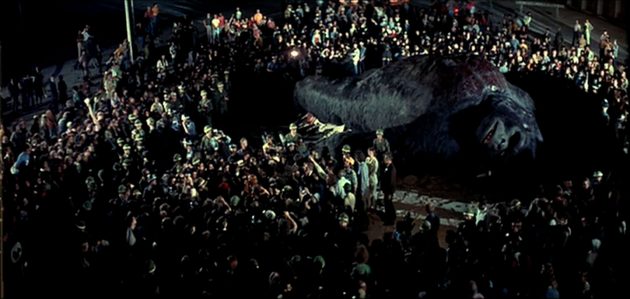In the kaiju fandom which is so often dominated by the scaly likes of Godzilla, Gamera, Rodan etc., it is quite easy to be labelled a Kong sympathiser. Personally, I can say that I straddle the divide of loving Kong and resenting him. For many persons who probably find themselves in a similar predicament, my guess is that any resentment attributed to Kong comes from him thrashing everyone’s hero Godzilla in 1962.
Because of this and perhaps him being more mammalian, and more natural (compared to the likes of say…Godzilla) Kong doesn’t always get the same press as some of his kaiju brethren. Again, a creature very closely modelled of of a gorilla is probably not as exciting as creatures who have more in common with dragons. In a lot of cases in the kaiju fandom, which is honestly fairly amicable, Kong can illicit heated debate despite the fact that the 1933 King Kong film is arguably the film responsible for the genre itself. This gives Kong a very interesting place among kaiju film fans: He is loved, and yet kept at an arm’s length, he is acknowledged as a classic, but not immediately recommended. A fandom hero and outcast all at once.
There have been a few Kong remake films over the years, and many knock off films (KONGA for example) however it is safe to say the bold, original premise of Kong’s first outing hasn’t been duplicated in terms of success or originality. Arguably Peter Jackson’s 2005 re-make has honoured the original film’s plot and presentation the best among the Kong films that have come along. But in this article however, I want to discuss the Dino De Laurentiis King Kong films and how they actually hold up pretty well within the standards expected by the kaiju fandom. Yet, like their simian star, they are not widely toted by the fandom.
The first of the two Dino De Laurentiis films, and widely considered the better is King Kong (1976). With an updated plot to reflect the decade the film is set within and a new cast of characters, the film does, to a degree follow a similar course as the original. However, what keeps it feeling fresh is it’s not trying to duplicate the plot of the original. Because of this, the film tends to stand up well on its own. In my opinion (hey you are reading my article) one of the few flaws that Jackson’s Kong had is he tried to be a direct remake of the original, albeit with a few extended bits added it. As beautiful a film as Jackson’s is then, we already know pretty much everything that is going to happen in it. One of the reasons Kong: Skull Island likely did so well is because people could come for the character they enjoy, and not have the same plot regurgitated to them.
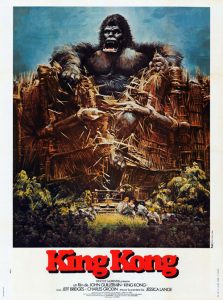
The ’76 film itself revolves around an expedition put forward by the fictitious Petrox oil company. As the story goes, the crew are venturing to a newly verified island which is likely to have some pretty nice oil deposits. I say newly verified because “The Dude” himself, Jeff Bridges, in this film playing primate palaeontologist Jack Prescot ( a take on the classic character Jack Driscoll), gives many cases when mankind has encountered what fans will know to be Skull Island. Interestingly, our Ann Darrow in this film (who isn’t named Ann or Darrow by the way) appears well after the ship has left the harbour, and is actually rescued at sea. The memorable plot of King Kong, with a few differences thrown in to reflect the times progresses, becomes: well, this island has no oil…but it does have something we could use to recoup our losses. Predictably, Kong escapes his captors, abducts poor damsel (we don’t have a very empowering actress in this film unfortunately) and causes a bit of chaos in New York. Unlike the original film however, the end of this film has several small differences that set its tone apart from any other Kong film climax.
What this film gets right is pacing. The original Kong, while it has its iconic status and charm, can drag on a bit if you have already seen it once or twice. Jackson’s film, as I stated earlier, just has too much in it, it feels like a movie marathon. Kong: Skull Island has good pacing, but as a franchise Monsterverse film, I personally did not feel that connected to Kong as a character. Many of the more interesting plot points occurred with him off screen. The 1976 Kong however has a good build up, and it seems like a relatively normal thing for an oil company to go exploring. The boat also sets out from Singapore rather than New York, giving us another set in addition to being more in tune with the part of the world that they are to be visiting. The time spent on Skull Island, which it is never definitively called in this film, is also well managed. Come to think of it, each arc of the film, beginning, middle and end all neatly split into thirds giving the film a nice balance which is felt when you watch it. This makes it a great “bored movie”, and the plot, while its has its subtleties, is never so complex that you can feel lost or that one section of the film drags the rest down. I think John Guillermin, the director, deserves more credit for this.
The other aspect of the film which is well done are all of the effects work that went into it. Of course, the first thing that people say when they see Kong in this film is “But that is just a guy in a gorilla costume!?”. My response is typically “And Godzilla is what then?” or something similar. There is a lot that goes into making a convincing gorilla (or similar) costume. Facial expression, fur, posture etc all have to be taken into serious consideration because this is creature based on a very real type of animal. Film goers know what a gorilla is, and they have an expectation. A creature that is made up from scratch has the benefit of the doubt.
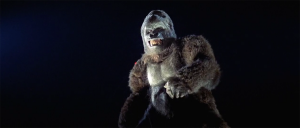
Suitamation aside, the film boasts some very impressive life sized practical effects. Kong’s hand and arm, used in scenes where he is grasping, reaching etc is a great piece of machinery, and if that doesn’t impress you, the life sized animatronic King Kong that is used in the film’s climax, along with a life sized body (post fall) are really something to behold.
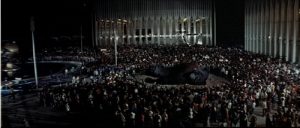
I will however and call out the one special effect that does not work, and that is the giant snake that Kong does battle with on the island. I understand why the scene is there, the original film had Kong facing off against all manner of prehistoric island denizens. It also makes Kong more empathetic as it shows him defending Dwan, the subject of his affections. The snake is goofy. There is just no other way to describe it.
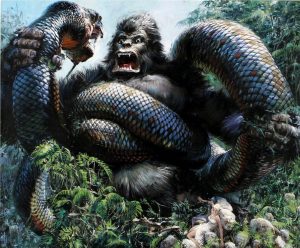
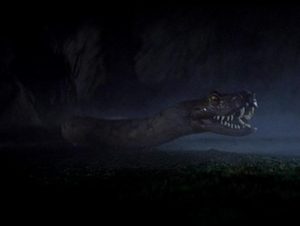
The effects are a great reflection of the artistry and limitations at the time when this film was made, and if you have an appreciation for practical effects, the film will not disappoint. But if you are a fan of incredible acting and dialogue….well….
This is a film…that is a remake/re-imagining, and its official tagline is: The most original picture event of all time.
That says a bit.
However, what you need to remember is that this is an American-Italian joint production and it was intended for a world wide audience, so the dialogue and translations are what they are. There are some lines like: “There is a girl out there who might be running from her life from gigantic, turned on ape”, while other bits of dialogue are pretty well written and profound, such as: ” He was the terror, the mystery of their lives, and the magic. A year from now that will be an island full of burnt-out drunks. When we took Kong we kidnapped their God.”
Jessica Lange, was lambasted by critics for her portrayal as Dwan, the film’s heroine. To be fair to her though, the character that she is asked to portray is a bit of a ditz, who through this experience grows a lot as a person. I think the majority of the dialogue that people poke fun at in this movie is Dwan’s. But that is her character. Dwan has the most character growth through the film, and she goes from being a person who does not have a real great grip on the harsh realities of the world, a comic relief and eye candy, to someone who is shackled with such remorse and loss that by the end it completely overwhelms her. You are left feeling so sorry for her, the pariah of the film. I loved her performance and while in the beginning her character isn’t portrayed very seriously I believe that anyone who reads this review and re-watches the film may have a deeper appreciation from the perhaps different perspective that is being offered here. At the end of the film when the former comic relief is standing amidst a crowd press hounds, covered in blood and crying out for a man she sees come, and then, rather than embrace or comfort her, just stand there stoically, purposefully beyond her reach is haunting for all of the right reasons.
The leading man, Jeff Bridges plays his part well, he is a good actor and delivers all of his lines well. The performance is not extraordinary, but it is solid and at no point does his character ever really change. He is a scientist, a seemingly nice guy and an ass-hole all at once. But Bridges’ Jack Prescot is mainly in the film to react to Kong and Dwan, and in this sense he fulfils his obligation. Any male actor in any Kong film has to understand, he will not be the male star of the film. That is reserved for Kong.
The other character which gets a lot of screen time is Fred Wilson, our cookie cutter, slime ball oil executive who has staked his career on this venture (pun intended). He is this film’s Carl Denham and he plays the part well, only where Denham was clever and willing to take the risks which were ultimately his undoing, Fred isn’t quite clever enough and his risks do not pay off. Fred Wilson is played by Charles Grodin, who for those who love their film trivia, actually had an un-credited role in Disney’s adaption of 20,000 Leagues Under the Sea (he was the kid drummer). Fred is the character we all love to hate, and yet he isn’t a bad person, he just wants to have the success that ultimately never comes his way. Charles does a good job of portraying the character and you can see a bit of the comedic skills he would later put to good use come out in this film.
All in all, the film has its quirks, but it is still a very watchable, and very good attempt at recreating some of the magic of the original King Kong before the time of CGI, inflated budgets and franchises. It has all the things that a kaiju film fan should love, practical effects, decent pacing, decent acting with questionable dialogue (a staple of monster movies in general folks…you know it is) and a predictable yet engaging story. In many ways it does not deserve the stigma attached to it, and as I have said earlier in the article it is a decent stand alone film…..if only it was a stand alone film….
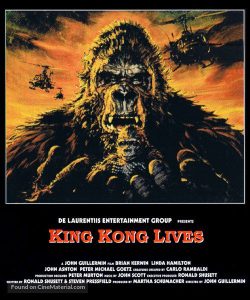
Yes. There was a sequel. Is it good? No. Is it watchable? Yes.
…but for all the wrong reasons…
Joe out folks – thanks for reading, and as always: Keep it Kaiju!!!

